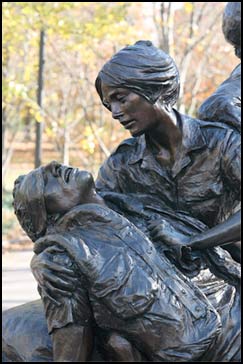
In January of this year, it was widely reported that in the 2006-2010 period, the number of female veterans experiencing homelessness had more than doubled. The jump was from 1,380 to 3,328. One thing to remember about this number is, it doesn’t count the female vets in shelters. But a shelter is for emergency and transition, not for permanent residence. Technically, those women are homeless too.
And, of course, the number only includes individuals who had actual contact with the VA. Nobody knows how many are constrained, by inner or outer circumstances, from asking the government for anything. It is a truism of the field of social work, that the people who most need help are often the last ones to seek it.
The numbers that express the need are difficult to gather accurately, and there is always a time lag between conditions when the count is made and the day when the results are collated and published. It is even said (by the General Accounting Office, or GAO) that the true picture is difficult to assess because of a lack of coordination between the VA and the department of Housing and Urban Development. A PDF file of the GAO’s December 2011 report, “Homeless Women Veterans,” is downloadable here.
A recent New York Times editorial said:
Lack of information is part of the problem. The report said that neither the V.A. nor the Department of Housing and Urban Development collects sufficiently detailed information about homeless female veterans, making it harder to plan effective programs, allocate money and track progress.
There are two sides to that particular problem, of course. Those named activities all come under the heading of “bureaucracy,” more layers of it, and more money going for offices, computers, software, clerks, and paper clips. Meaning, ultimately, less money for the actual troops on the ground — the military veterans who can’t find a place to sleep in their native land.
The administration/action ratio of any nonprofit corporation is what people want to know before they donate to it. If the organization is paying more than 50% of its income to keep itself running, a red flag goes up. Hopefully, some government bureaucracy is keeping an eye on other government bureaucracies, making sure they adhere to some kind of standard.
The same editorial describes the discouraging parts of the December document and another:
The report found that the V.A. sometimes failed to refer homeless women to short-term housing while they waited for housing vouchers. It noted that the agency lacked safety standards for shelter providers, even though many women said they feared sexual harassment and assault. And some shelters discriminated against homeless mothers by limiting the age or number of children they take.
A report in March by the V.A. inspector general echoed these concerns, saying some shelters lacked basic protections like working locks and separate floors for men and women. The V.A.’s inattention to safety and privacy is especially troubling because rates of sexual trauma and domestic violence tend to be high among homeless female veterans.
Experts see many reasons for the increase in female veteran homelessness: the general unraveling of the social safety net, the outsourcing of jobs overseas, the gentrification of central urban areas with the consequent loss of affordable housing. Add to that the increase of domestic violence. As Richard R. Troxell of House the Homeless, a Vietnam veteran himself, phrases it:
Female veterans face all the same economic challenges as the men AND so much more… The level of sexual abuse for women in the military is appalling. So these women potentially have one cause for PTSD even before their life unravels and they end up on the streets.
That’s a big problem, and one that nobody much wants to face. There are women veterans who not only endured sexual abuse while in service, but also suffered from the indifference or hostility of the military establishment when they tried to get justice. If such a woman later becomes homeless, it’s easy to see why she would be reluctant to approach the government for help.
Women veterans face a different set of risks and needs than male vets, and it’s all part of a larger issue. Whether they are former military personnel or perpetual civilians, homeless women are even more vulnerable than homeless men. We were reminded again of this in June, when Valerie Godoy was murdered in Texas. The people of Austin have responded by proposing the creation of a new and much-needed women’s shelter. Please sign the petition!
Reactions?
Source: “Homeless Women Veterans” (PDF), GAO.gov, December 2011
Source: “Homelessness Among Female Veterans,” The New York Times, 04/17/12
Image by cliff1066, used under its Creative Commons license.


